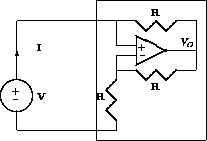EECS 210_________________________PROBLEM SET #6________________________Winter 2001
ASSIGNED: February 16, 2001. Read: Chapter 6 of text and Chapter 4 of Additional Course Notes.
DUE DATE: February 23, 2001. In Lab Book: Read all material on Unit #3 and Lab Experiment #3.
THIS WEEK: Basic op-amp circuits.
- Text #5.2. HINT: You should recognize this circuit from Chapter 5.
Old texts: Change the 6V voltage source to a 24V voltage source.
- Text #5.6. Note the op-amp output current is nonzero, even though in=ip=0
(KCL doesn't hold).
Old texts: Change the 10 mA current source to a 1 mA current source.
- Text #5.8a. HINT: Replace the combination {vg=0.5; 3.2k; 4.8k} with its Thevenin equivalent
Then this problem is easy! Note 0 < sigma < 1 is the fraction tapped in the 170k potentiometer.
- Text #5.14. Draw the circuit and specify each resistor value. Assume op-amp doesn't saturate.
- Text #5.20. Voltage or source follower circuit. The source could be a real-world voltage sensor.
- Text #5.36. Use of Matlab is not necessary if you make a decent plot by hand. Similar to prelab.
- Show that the ideal op-amp circuit depicted below acts like a negative resistor: v=-iR.
This means that the power "dissipated" by it is actually i² R < 0, so that it supplies power!
Explain why we have not discovered perpetual motion or disproved conservation of energy.
 "Mr. Lawyer, what is your fee for answering three questions?" "$1000." "Isn't that steep?" "Yes.
What is your final question?"
"Mr. Lawyer, what is your fee for answering three questions?" "$1000." "Isn't that steep?" "Yes.
What is your final question?"
 "Mr. Lawyer, what is your fee for answering three questions?" "$1000." "Isn't that steep?" "Yes.
What is your final question?"
"Mr. Lawyer, what is your fee for answering three questions?" "$1000." "Isn't that steep?" "Yes.
What is your final question?"